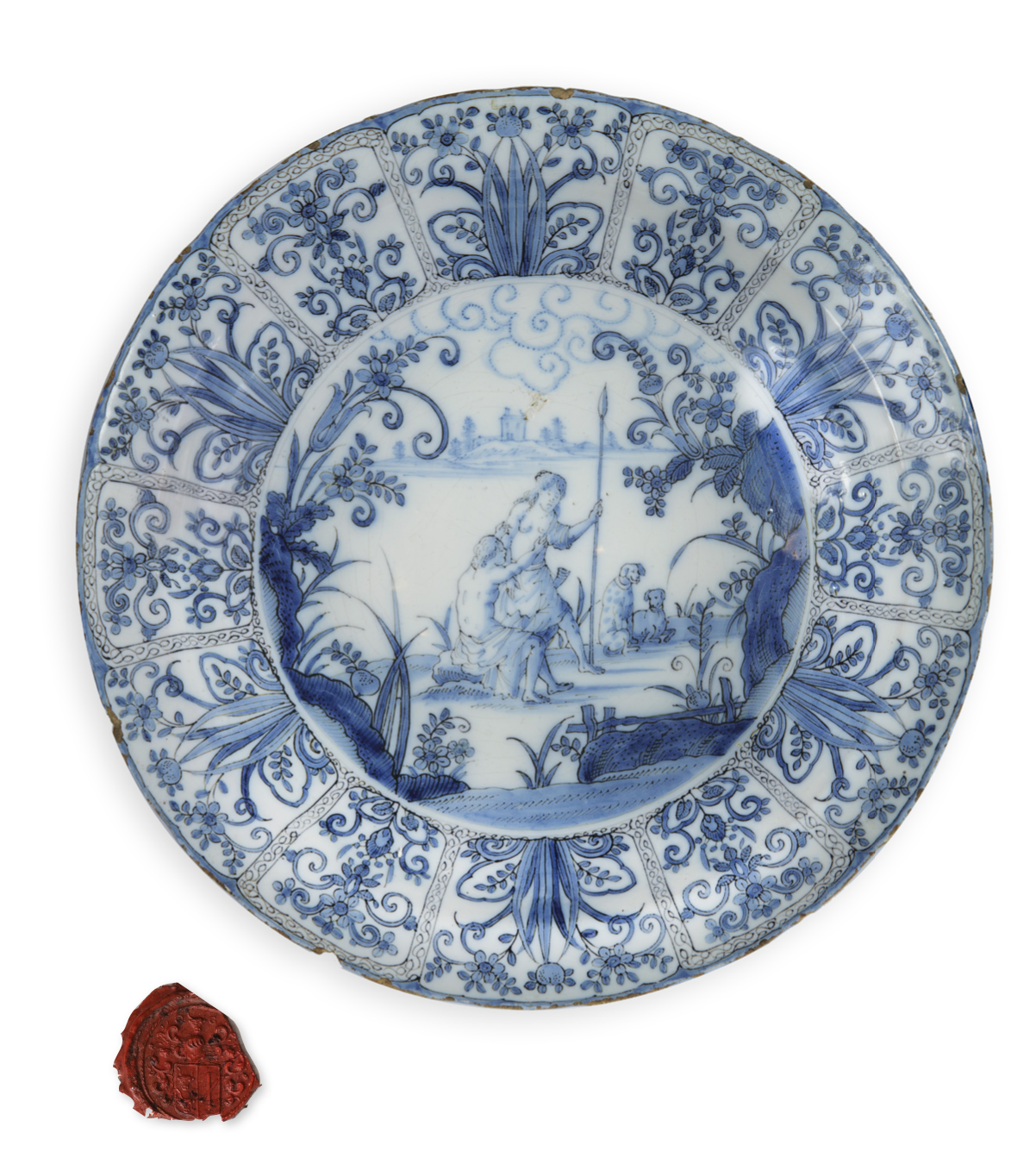
Collecting Delft Faience: De Ramaix Collection
Delftware did not always attract the attention it receives today or that it enjoyed in the seventeenth and eighteenth centuries. Its notoriety can be attributed to the interest and patronage of royalty and nobility. The role of specific collectors has also been influential, as their efforts and dedication for collecting continue to form the foundation of our national art heritage today. In this article we focus on the collection of a Belgian diplomat, Maurice de Ramaix (1850-1918) and his eldest son Gaston (1878-1937).
After the wave of interest in Delftware in the seventeenth and eighteenth centuries, its popularity declined. The renewed interest in Delft faience was sparked by an “Exhibition of Antiquities” held in Delft in 1863. The exhibition drew considerable attention from both the nobility and royalty, as demonstrated by the subscription list in the accompanying album dedicated to Queen Frederika Sophia Mathilda of the Netherlands, who, for instance, visited the exhibition three times.(1)
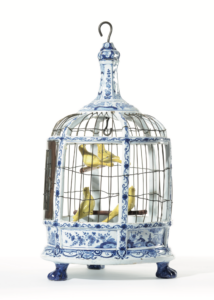
The Delft faience objects were described as follows: “Rarely has such a treasure of Delft pottery been brought together as at the Delft Exhibition, including the finest specimens, outstanding for their delicacy of drawing, freshness of color, excellence of glaze, and beauty or whimsicality of form. The imitation of Japanese or Chinese porcelain, the masterful designs on some tiles, plates, and bowls, all deserved the admiration of the thousands of visitors. Some showed a single figure, a few flowers, or a simple landscape, in loose blue outlines with some flat shadows. Others, on the other hand, were more elaborately executed and showed an effort to imitate the coloring and effect of works by great masters.”(2)
This fostered an ideal environment for collecting among those with the means, interest, and ambition to enter the highest echelons of society. And for those who were already part of this, it was a way to demonstrate their sophistication and refined taste.
Maurice de Ramaix came from a wealthy family in Belgium. Although he lacked an official noble title at the time, he certainly had noble aspirations.(3) After postings in Paris, Istanbul, Vienna, Berlin, and Brussels, his assignment to the administrative capital of the Netherlands was delayed due to the death of his first wife, Cécile De Meester (1856-1882). Maurice began his diplomatic post in The Hague in September 1882.(4) He then remarried the Dutch Marie Suermondt in 1884. The Suermondt family was part of The Hague’s high society and resided on an estate that had previously been owned by Prince Alexander and Princess Anna Pavlovna.(5) The wedding guests included both nobles and royalty.
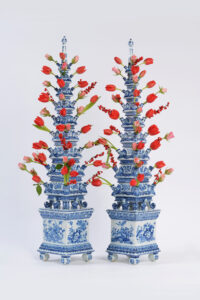
Maurice and Marie lived in the embassy district on the Javastraat in The Hague. Within The Hague’s diplomatic circles, De Ramaix developed a sense of nobility and a passion for the artistic treasures he encountered, such as the recently rediscovered Delft pottery. As part of his professional duties, Maurice wrote a publication on Dutch industry that covered various topics, including the production of Delftware, titled “La Néerlande industrielle, considérée au triple point de vue de la production, de l’exportation et de l’importation”.(6) The section on Delft faience clearly reflects his appreciation for this national product. He expresses particular appreciation for the wares of ‘De Porceleyne Fles’ (Royal Delft), the only surviving Delftware factory with roots in the seventeenth century.
Although the exact timing and inspiration behind Maurice’s interest in collecting Delftware remain unclear, several factors beyond his publication on Dutch industry likely played a role. As a diplomat married into the prominent Suermondt family, Maurice was well-connected within an elite circle of collectors. It is highly plausible that he crossed paths with significant figures such as John Ferdinand Loudon (1821–1895), who was part of this same social milieu. Loudon, known for acquiring much—if not all—of the Delftware collection of Charles A.E. Baron de la Villestreux, secretary of the French delegation in The Hague, also maintained connections with diplomats, including the Austrian envoy Ferdinand Freiherr Baron von Langenau (1817–1881).
Maurice also had at least one documented meeting with Victor de Stuers, a notable Delftware collector, though it is unknown whether they discussed Delft faience or whether the meeting fostered further engagement.(7)
Maurice had ample opportunities to encounter Delftware firsthand, such as at the 1883 Exhibition of Retrospective Art in Amsterdam, where Delft faience was prominently displayed, undoubtedly drawing attention from collectors in The Hague. Additionally, Henry Havard’s recently published standard work on Delftware, which focused on Loudon’s collection, may have further inspired Maurice to begin building his own collection.
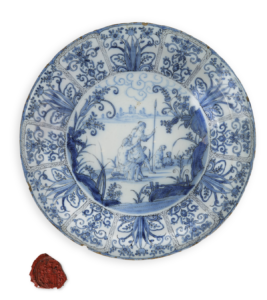
Maurice resided in The Hague until 1890, and was then briefly stationed in Persia. His diplomatic career came to an end soon after, due to health issues. Nevertheless, he remained active, serving as a member of parliament and participating in the corporate sector. In 1890, his noble ambitions were further fulfilled with the purchase of a castle in Grune, in the Belgian Ardennes.(8) By this time, he had likely already begun collecting Delftware. By 1913, the collection had taken on a significant form.(9) In the years leading up to his death in September 1918, he lived a reclusive life at the castle. After his death, the collection was divided among his four children, with part of it later making its way to the market.
Unfortunately, no sources offer insight into how Maurice assembled his collection or whether a particular philosophy guided his choices, apart from the surviving pieces themselves. One piece carries a label from the Antwerp antique dealer Van Herck. Although this does not definitively prove he bought the object directly from the dealer, it is quite plausible. Maurice must have been familiar with art dealers from the Hague and certainly Antwerp, and perhaps he bought at art auctions.
An inventory from 1920, prepared on the occasion of the marriage of Maurice’s eldest son Gaston, provides a glimpse into at least part of the collection by that time.(10) Several pieces in the inventory bear one of several collection labels, including a red wax seal with a coat of arms. One label bears Gaston’s name, suggesting that he continued to expand the collection. This assumption is supported by oral tradition, although there is no detailed knowledge of Gaston’s specific contributions.(11)
The unifying characteristics of the remaining collection are found in the rich and intricate decorations. The objects also share the recurring themes of nature, history and nobility. The pieces reflect a particular preference for seventeenth-century blue and white Delftware, though examples from the eighteenth century are also represented. In addition to blue and white, Maurice and possibly Gaston, also collected polychrome Delftware, especially plaques. Birds play a prominent role in the collection; they often appear as decorative elements on polychrome plaques. The most notable example is an early eighteenth-century birdcage with four yellow birds, probably added in the 1760s. The birdcage was formerly part of the Aronson Collection and is now held in a Dutch private collection (fig. 1). This exceptional piece truly exemplifies De Ramaix’s collection, demonstrating his discerning eye for quality and his passion for collecting.
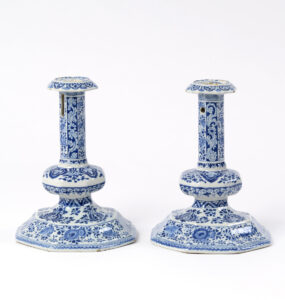
Another major highlight that once belonged to the De Ramaix collection is a pair of blue and white pyramidal flower vases marked for the De Witte Ster (The White Star) factory, attributed to Dirck Witsenburgh, co-owner of the factory from 1690-1704 (fig. 2). Maurice further enhanced his collection with an extremely rare dish by Jacob Wemmersz. Hoppesteyn, the owner of the Het Moriaanshooft (The Moor’s Head) factory from 1664 until 1671, whose widow Jannetge Claesdr. van Straten continued operations until 1686. The dish features a scene of Adonis and Venus after a drawing by Leonard Bramer (1596-1674) (fig. 3). The work produced by this factory during this period is among the finest examples of Delft pottery that closely resembles Chinese porcelain.
Another example, a pair of blue and white candlesticks, each marked and numbered LVE G 12, along with an unidentified squiggle in blue for Lambertus van Eenhoorn, owner of the De Metaale Pot (The Metal Pot) factory from 1691 to 1721, serve as a fine example of the delicate yet rich decorative style Maurice favored (fig. 4). His historical interests are reflected in a remarkable plaque depicting either the Twelfth Siege of Gibraltar in 1704-1705 or the Great Siege of Gibraltar in 1779, which he acquired before 1913 (fig. 5).(12) Maurice’s sense of nobility is represented by an armorial charger attributed to the workshop of Willem Jansz. Verstraeten in Haarlem (fig. 6).
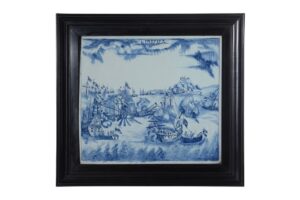
The Collection de Ramaix exists only in remnants; the objects were never catalogued or donated to a museum. However, the objects Maurice acquired still hold considerable art historical significance in contributing to the broader history of Delft faience. This collection highlights the important role collectors play in preserving the cultural heritage of Delft faience. Just as Maurice once found inspiration from fellow collectors, his collection now serves as a source of inspiration for future generations, ensuring that the beauty and history of Delft pottery continue to be cherished and conserved.
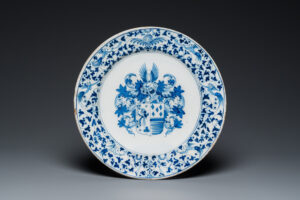
We acknowledge the research conducted on the family’s history by Prof. Dr. Jo Tollebeek, some of which was published in his article, ‘The Collection de Ramaix. The Diplomatic Corps, noble status and the reappraisal of Delftware’, in: Virtus: Journal of nobility Studies, No 30, Amersfoort, 2023.
Notes
1. H.C. Rogge, 1863, p. 4
2. H.C. Rogge, 1863, p. 13
3. Tollebeek, 2023, p. 112
4. https://www.odis.be/hercules/toonPers.php?taalcode=nl&id=4956
5. Tollebeek, 2023, p.109
6. https://archive.org/stream/lachambredesrep00riddgoog/lachambredesrep00riddgoog_djvu.txt and Tollebeek, 2023, p.111
7. 2.21.355 Inventaris van het werkarchief van V.E.L. de Stuers [levensjaren: 1843-1916] over de jaren (1790) 1859-1916, file 250
8. Tollebeek, 2023, p.114
9. Based on the family’s oral tradition
10. Tollebeek, 2023, p.121
11. Aronson, Ariaans and Serra, 2018, p. 5
12. The provenance of this object has been registered with independent and secured notary registration agency Provenance+ Amsterdam.
Literatuur
Aronson, R, C. Ariaans and S. Serra, Tangible memories. The Mr. & Mrs. H.C. Bout Collection, the Gaston de Ramaix Collection and other recent acquisitions, Amsterdam, 2018
Rogge, H C. ‘Album. Verzameling van afbeeldingen der merkwaardigste voorwerpen, ingezonden voor de TENTOONSTELLING VAN OUDHEDEN, gehouden te DELFT, in Julij en Augustus 1863; met beschrijving van H.C. Rogge’, 1863
Tollebeek, J.,‘The Collection De Ramaix’,in: Virtus. Journal of Nobility Studies, No. 30, Amersfoort, 2023



